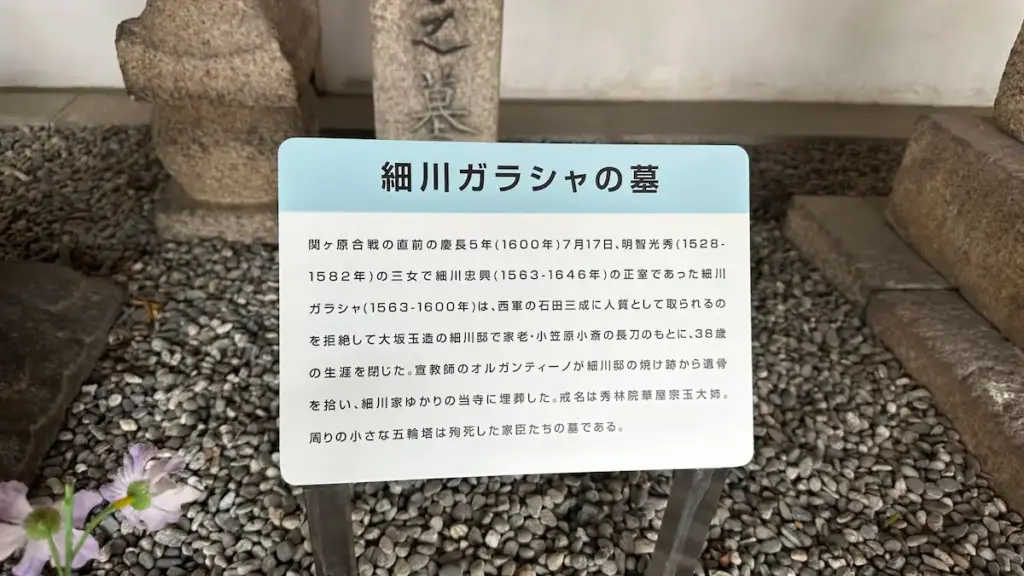From “Shogun” to Sōzen-ji: The Real Lady Mariko
If you were moved by Lady Mariko in Shogun, discover the true story of her inspiration—Hosokawa Gracia. At Sōzen-ji Temple in Osaka, you can visit her actual grave and walk through centuries of drama, faith, and samurai legacy.
🚉 How to Get Here Shi-Osaka satation
From Kansai International Airport (KIX)
Approx. travel time: 60 minutes
Fare: 1,260 yen
From Shin‑Osaka Station
You are already at your destination station.
Approx. travel time: 0 minutes
Fare: 0 yen
Sōzen-ji Temple

🏛 Overview
Nestled in Higashiyodogawa Ward, Osaka City, Sōzen-ji Temple traces its origins back to the Tempyo era (729–749 AD), founded by the renowned Buddhist monk Gyōki. Over the centuries, the temple has transitioned through various sects—from Hossō to Sōtō Zen—preserving a continuous thread of spiritual and cultural history from the Nara period to the present day.
A pivotal moment in its history occurred during the Kakitsu Rebellion in 1441, when Shōgun Ashikaga Yoshinori was assassinated by Akamatsu Mitsusuke. According to temple lore, Yoshinori’s head was abandoned at Sōzen-ji. In response, the temple was solemnly revitalized under the patronage of Hosokawa Mochikata, becoming the family temple for both the Ashikaga and Hosokawa clans.
Due to this connection, in the year 1600, the remains of Hosokawa Gracia (also known as Tama, daughter of Akechi Mitsuhide) were reinterred here from Sakai by Christian missionaries. She now rests behind the main hall, beside Yoshinori’s burial mound. Today, Sōzen-ji continues to draw visitors as a site rich in history, religious significance, and as a poignant symbol of the tragic yet noble life of a samurai woman—Gracia, the inspiration for Lady Mariko in the drama Shogun.
🗺 Address:
5-27-44 Higashinakajima, Higashiyodogawa-ku, Osaka, Japan
🚶 Access:
Approx. 10-minute walk from JR/Osaka Metro Shin-Osaka Station
(a major bullet train stop on the Tokaido and Sanyo Shinkansen lines)
Approx. 5-minute walk from Hankyu Kyoto Line Sōzenji Station
⏳ Recommended Visit Duration:
In-depth tour: Approximately 1 hour
Quick visit: Around 20–30 minutes
📍 Highlights
🔹 Gravesite of Ashikaga Yoshinori and Hosokawa Gracia
Behind the main hall lies a solemn cemetery featuring the burial mound of Shōgun Yoshinori’s head and the stone monument for Gracia’s remains. Although other possible sites exist—such as in Harima—the temple’s preserved records lend historical weight to Sōzen-ji’s claims.
🔹 Temple Complex and Revival History
The temple’s restoration was led by Tokusō Kyōrin, invited to serve as the new founding priest during the revival period. With donations from Hosokawa Mochikata and Katsumoto, the temple’s domain grew, solidifying its influence in the Nakajima area.
🔹 Expansive Grounds and Cultural Heritage
Sōzen-ji once continued to expand its estate, and today, visitors can explore remnants from both the Nara and Edo periods. Scattered throughout the site are features like tea garden pavilions and monuments honoring war dead, offering a blend of history and serenity.
🔹 Seasonal Atmosphere
With cherry blossoms and camellia shrubs adorning its grounds, Sōzen-ji provides a peaceful escape from the bustle of Shin-Osaka, inviting visitors to reflect amid the tranquil beauty of the changing seasons.
📌 Trivia
💡 Why is Gracia buried here?
After the Hosokawa residence burned down, Gracia’s remains were initially interred in a Christian churchyard in Sakai by missionaries. They were later moved to Sōzen-ji, the Hosokawa family’s designated temple, ensuring her final rest in accordance with her heritage.
💡 The Mystery of Yoshinori’s Head Mound
While the authenticity of the burial mound remains debated, local records and historical testimony uphold Sōzen-ji’s role as a place of mourning for Yoshinori’s remains.
💡 Gracia’s Final Words
Her poignant farewell poem, beginning with “To know the time to fall like a flower…”, continues to echo her unwavering faith and noble spirit, resonating across centuries.

On July 17, 1600 (Keichō 5), just before the Battle of Sekigahara, Hosokawa Gracia (1563–1600)—the third daughter of Akechi Mitsuhide (1528–1582) and the lawful wife of Hosokawa Tadaoki (1563–1646)—ended her life at the age of 38. She chose death over being taken hostage by the Western Army led by Ishida Mitsunari, perishing at the Hosokawa residence in Tamatsukuri, Osaka, under the blade of the retainer Ogasawara Kosai.
After the residence was set ablaze, Jesuit missionary Organtino recovered her remains from the ruins. They were later interred at Sōzen-ji Temple, which was associated with the Hosokawa family. Her Buddhist posthumous name is Shūrin’in Kayasōgyoku Taishi (秀林院華屋宗玉大姉).
Surrounding her gravestone are several small gorintō (five-tiered pagoda-style gravestones), marking the final resting places of retainers who committed junshi (ritual suicide in loyalty) following her death.


comment